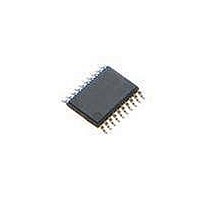P89LPC972FDH,129 NXP Semiconductors, P89LPC972FDH,129 Datasheet - Page 28

P89LPC972FDH,129
Manufacturer Part Number
P89LPC972FDH,129
Description
MCU 80C51 8KB FLASH 20TSSOP
Manufacturer
NXP Semiconductors
Series
LPC900r
Datasheet
1.P89LPC970FDH129.pdf
(66 pages)
Specifications of P89LPC972FDH,129
Program Memory Type
FLASH
Program Memory Size
8KB (8K x 8)
Package / Case
20-TSSOP
Core Processor
8051
Core Size
8-Bit
Speed
18MHz
Connectivity
I²C, SPI, UART/USART
Peripherals
Brown-out Detect/Reset, POR, PWM, WDT
Number Of I /o
18
Ram Size
256 x 8
Voltage - Supply (vcc/vdd)
2.4 V ~ 5.5 V
Oscillator Type
Internal
Operating Temperature
-40°C ~ 85°C
Processor Series
P89LPC
Core
80C51
Data Bus Width
8 bit
Data Ram Size
256 B
Interface Type
I2C, SPI, UART
Maximum Clock Frequency
18 MHz
Number Of Programmable I/os
15
Number Of Timers
5
Operating Supply Voltage
2.4 V to 5.5 V
Maximum Operating Temperature
+ 85 C
Mounting Style
SMD/SMT
3rd Party Development Tools
PK51, CA51, A51, ULINK2
Minimum Operating Temperature
- 40 C
Lead Free Status / RoHS Status
Lead free / RoHS Compliant
Eeprom Size
-
Data Converters
-
Lead Free Status / Rohs Status
Lead free / RoHS Compliant
Other names
935290299129
NXP Semiconductors
P89LPC97X
Product data sheet
7.17.3.1 Idle mode
7.17.3.2 Power-down mode
7.17.3.3 Total Power-down mode
7.17.2 Power-on detection
7.17.3 Power reduction modes
7.17.4 Regulators
The Power-on detect has a function similar to the brownout detect, but is designed to work
as power comes up initially to ensure that the device is reset from Power-on. The POF
flag in the RSTSRC register is set to indicate an initial power-up condition. The POF flag
will remain set until cleared by software.
The P89LPC970/971/972 supports three different power reduction modes. These modes
are Idle mode, Power-down mode, and total Power-down mode.
Idle mode leaves peripherals running in order to allow them to activate the processor
when an interrupt is generated. Any enabled interrupt source or reset may terminate Idle
mode.
The Power-down mode stops the oscillator in order to minimize power consumption.
Brownout detection circuitry is disabled. The P89LPC970/971/972 exits Power-down
mode via any reset, or certain interrupts.
Some chip functions continue to operate and draw power during Power-down mode,
increasing the total power used during power-down. These include: Brownout detect,
watchdog timer, comparators and RTC/system timer (note that watchdog timer,
comparators and RTC/system timer can be powered down separately). The internal RC
oscillator is disabled unless both the RC oscillator has been selected as the system clock
and the RTC is enabled.
The total Power-down mode is a deeper power reduction mode. Brownout detection
circuitry and analog comparators are disabled, as well as the internal RC oscillator.
Please use an external low frequency clock or 25 kHz watchdog oscillator to achieve low
power with the RTC running during power-down.
Internal regulators can be adjusted automatically to minimize power consumption during
different power reduction modes. In Normal or Idle modes, power consumption can be
further reduced by configuring PMUCON register.
In Normal or Idle mode, regulators have two operation modes: High-speed mode and Low
current mode.
The regulators can be configured to Low current mode to reduce the power consumption.
After power-on-reset, internal regulators enter into High-speed mode as default.
PMUCON register is used to configure the regulators operation modes. LPMOD bit is
used to select the regulator’s mode and HCOK bit indicates whether the switch completed
or not. When switching back to high speed mode, first clear LPMOD bit to select high
speed mode, then check HCOK bit. If HCOK bit turns to ‘1’, it means the switch was
completed.
All information provided in this document is subject to legal disclaimers.
Rev. 3 — 8 June 2010
8-bit microcontroller with accelerated two-clock 80C51 core
P89LPC970/971/972
© NXP B.V. 2010. All rights reserved.
28 of 66















